【演算法】堆,最大堆(大頂堆)及最小堆(小頂堆)的實現
此坑待埋。
下面來說一說具體演算法。
堆排序解釋第一篇(描述不太清楚)
1.堆
堆實際上是一棵完全二叉樹,其任何一非葉節點滿足性質:
Key[i]<=key[2i+1]&&Key[i]<=key[2i+2]或者Key[i]>=Key[2i+1]&&key>=key[2i+2]
即任何一非葉節點的關鍵字不大於或者不小於其左右孩子節點的關鍵字。
堆分為大頂堆和小頂堆,滿足Key[i]>=Key[2i+1]&&key>=key[2i+2]稱為大頂堆,滿足 Key[i]<=key[2i+1]&&Key[i]<=key[2i+2]稱為小頂堆。由上述性質可知大頂堆的堆頂的關鍵字肯定是所有關鍵字中最大的,小頂堆的堆頂的關鍵字是所有關鍵字中最小的。
2.堆排序的思想
利用大頂堆(小頂堆)堆頂記錄的是最大關鍵字(最小關鍵字)這一特性,使得每次從無序中選擇最大記錄(最小記錄)變得簡單。
其基本思想為(大頂堆):
1)將初始待排序關鍵字序列(R1,R2....Rn)構建成大頂堆,此堆為初始的無序區;
2)將堆頂元素R[1]與最後一個元素R[n]交換,此時得到新的無序區(R1,R2,......Rn-1)和新的有序區(Rn),且滿足R[1,2...n-1]<=R[n];
3)由於交換後新的堆頂R[1]可能違反堆的性質,因此需要對當前無序區(R1,R2,......Rn-1)調整為新堆,然後再次將R[1]與無序區最後一個元素交換,得到新的無序區(R1,R2....Rn-2)和新的有序區(Rn-1,Rn)。不斷重複此過程直到有序區的元素個數為n-1,則整個排序過程完成。
操作過程如下:
1)初始化堆:將R[1..n]構造為堆;
2)將當前無序區的堆頂元素R[1]同該區間的最後一個記錄交換,然後將新的無序區調整為新的堆。
因此對於堆排序,最重要的兩個操作就是構造初始堆和調整堆,其實構造初始堆事實上也是調整堆的過程,只不過構造初始堆是對所有的非葉節點都進行調整。
下面舉例說明:
給定一個整形陣列a[]={16,7,3,20,17,8},對其進行堆排序。
首先根據該陣列元素構建一個完全二叉樹,得到




20和16交換後導致16不滿足堆的性質,因此需重新調整

這樣就得到了初始堆。
即每次調整都是從父節點、左孩子節點、右孩子節點三者中選擇最大者跟父節點進行交換(交換之後可能造成被交換的孩子節點不滿足堆的性質,因此每次交換之後要重新對被交換的孩子節點進行調整)。有了初始堆之後就可以進行排序了。
此時3位於堆頂不滿堆的性質,則需調整繼續調整










0.待排序序列:
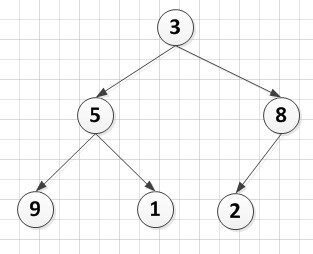 A[6]={3,5,8,9,1,2},
A[6]={3,5,8,9,1,2},
1.建堆後(建堆過程參見4.4):
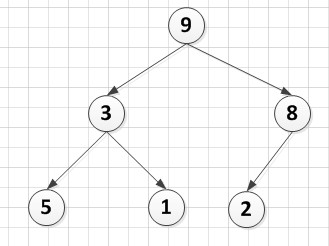 A[6]={9,3,8,5,1,2}
A[6]={9,3,8,5,1,2}
2.9和2交換,然後把9從堆中去掉後:
 A[6]={2,3,8,5,1,9}
A[6]={2,3,8,5,1,9}
3.篩選法調整堆A[5]={2,3,8,5,1}後(調整過程參見4.3):
 A[6]={8,3,2,5,1,9}
A[6]={8,3,2,5,1,9}
4.堆頂記錄與最後一個記錄互換,重複第二步,但是堆頂記錄和最後一個記錄的值變了
【附上另一篇文章---最大堆的插入/刪除/調整/排序操作(圖解+程式)(JAVA)】
最大堆的插入/刪除/調整/排序操作(圖解+程式)(JAVA)
堆有最大堆和最小堆之分,最大堆就是每個節點的值都>=其左右孩子(如果有的話)值的完全二叉樹。最小堆便是每個節點的值都<=其左右孩子值的完全二叉樹。設有n個元素的序列{k1,k2,...,kn},當且僅當滿足下列關係時,稱之為堆。

堆的三種基本操作(以下以最大堆為例):
⑴最大堆的插入
由於需要維持完全二叉樹的形態,需要先將要插入的結點x放在最底層的最右邊,插入後滿 足完全二叉樹的特點;
然後把x依次向上調整到合適位置滿足堆的性質,例如下圖中插入80,先將80放在最後,然後兩次上浮到合適位置.
時間:O(logn)。 “結點上浮”

程式實現:
//向最大堆中插入元素, heap:存放堆元素的陣列
public static void insert(List<Integer> heap, int value) {
//在陣列的尾部新增
if(heap.size()==0)
heap.add(0);//陣列下標為0的位置不放元素
heap.add(value);
//開始上升操作
// heapUp2(heap, heap.size() - 1);
heapUp(heap, heap.size() - 1);
}
//上升,讓插入的數和父節點的數值比較,當大於父節點的時候就和父節點的值相交換
public static void heapUp(List<Integer> heap, int index) {
//注意由於數值是從下標為1開始,當index = 1的時候,已經是根節點了
if (index > 1) {
//求出父親的節點
int parent = index / 2;
//獲取相應位置的數值
int parentValue = (Integer) heap.get(parent);
int indexValue = (Integer) heap.get(index);
//如果父親節點比index的數值小,就交換二者的數值
if (parentValue < indexValue) {
//交換數值
swap(heap, parent, index);
//遞迴呼叫
heapUp(heap, parent);
}
}
}
⑵刪除
操作原理是:當刪除節點的數值時,原來的位置就會出現一個孔,填充這個孔的方法就是,
把最後的葉子的值賦給該孔並下調到合適位置,最後把該葉子刪除。
如圖中要刪除72,先用堆中最後一個元素來35替換72,再將35下沉到合適位置,最後將葉子節點刪除。
“結點下沉”
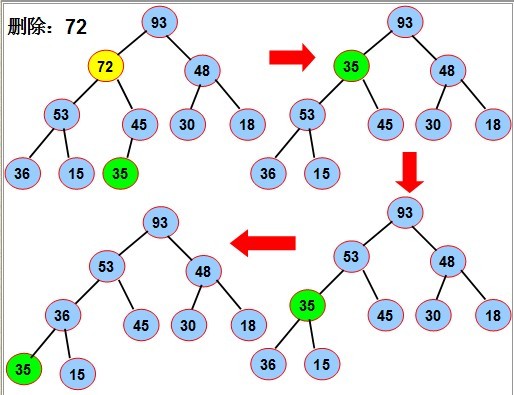 【勘誤】
大家看到上面的刪除過程是不是覺得很容易明白?
我也如此認為,直到我寫程式時候出現了問題才重新審視刪除演算法的正確性。
譬如說:現在有一個最小堆,如下圖:
【勘誤】
大家看到上面的刪除過程是不是覺得很容易明白?
我也如此認為,直到我寫程式時候出現了問題才重新審視刪除演算法的正確性。
譬如說:現在有一個最小堆,如下圖:
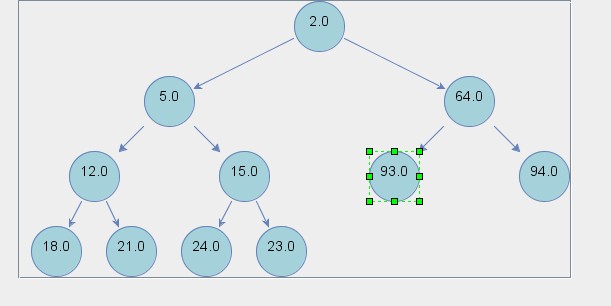
現在我選中了93,並且要刪除它,接下來會發生什麼事? 接下來就是這個演算法的結果了:

對,當節點沒有空間下沉的時候它就會無所事事,結果導致不對了。 這種情況下面我們可以借用插入過程的上浮調整方式,從最下面開始向上調整。
程式:
/**
* 刪除堆中位置是index處的節點
* 操作原理是:當刪除節點的數值時,原來的位置就會出現一個孔
* 填充這個孔的方法就是,把最後的葉子的值賦給該孔,最後把該葉子刪除
* @param heap
*/
public static void delete(List<Integer> heap,int index) {
//把最後的一個葉子的數值賦值給index位置
heap.set(index, heap.get(heap.size() - 1));
//下沉操作
//heapDown2(heap, index);
heapDown(heap, index);
//把最後一個位置的數字刪除
heap.remove(heap.size() - 1);
}
/**
* 遞迴實現
* 刪除堆中一個數據的時候,根據堆的性質,應該把相應的位置下移,才能保持住堆性質不變
* @param heap 保持堆元素的陣列
* @param index 被刪除的那個節點的位置
*/
public static void heapDown(List<Integer> heap, int index) {
//因為第一個位置儲存的是空值,不在考慮之內
int n = heap.size() - 2;
//記錄最大的那個兒子節點的位置
int child = -1;
//2*index>n說明該節點沒有左右兒子節點了,那麼就返回
if (2 * index > n) {
return;
} //如果左右兒子都存在
else if (2 * index < n) {
//定義左兒子節點
child = 2 * index;
//如果左兒子小於右兒子的數值,取右兒子的下標
if ((Integer) heap.get(child) < (Integer) heap.get(child + 1)) {
child++;
}
}//如果只有一個兒子(左兒子節點)
else if (2 * index == n) {
child = 2 * index;
}
if ((Integer) heap.get(child) > (Integer) heap.get(index)) {
//交換堆中的child,和index位置的值
swap(heap, child, index);
//完成交換後遞迴呼叫,繼續下降
heapDown(heap, child);
}
}
⑶初始化
方法1:插入法:
從空堆開始,依次插入每一個結點,直到所有的結點全部插入到堆為止。
時間:O(n*log(n))
方法2:調整法:
序列對應一個完全二叉樹;從最後一個分支結點(n div 2)開始,到根(1)為止,依次對每個分支結點進行調整(下沉),
以便形成以每個分支結點為根的堆,當最後對樹根結點進行調整後,整個樹就變成了一個堆。
時間:O(n)
對如圖的序列,要使其成為堆,我們從最後一個分支結點(10/2),其值為72開始,依次對每個分支節點53,18,36 45進行調整(下沉).
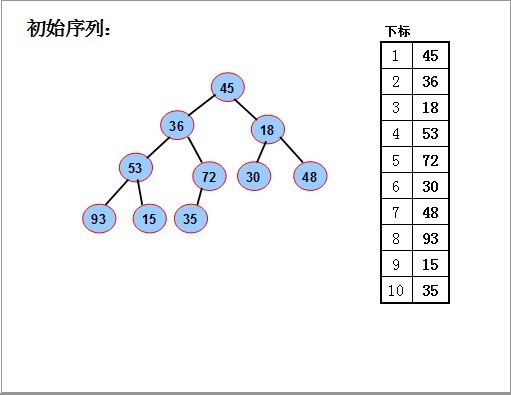
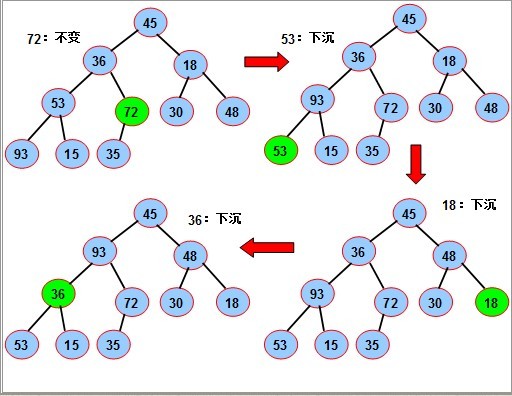
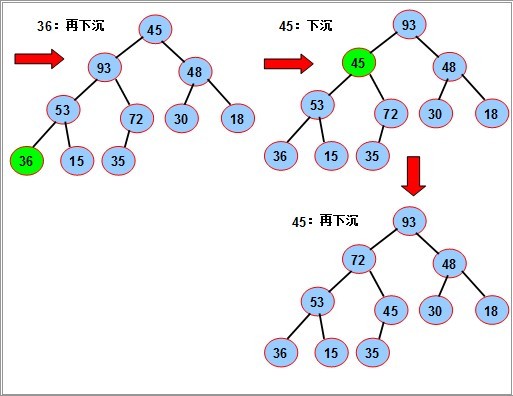 【補充說明】
如何獲取相應陣列序列?
方法是依次將堆的根節點的小數記下,然後刪除根節點,如此反覆直到堆為空。上面提到了刪除操作,每次刪除之後都是要調整堆讓堆的性質不變,即根節點必為最大值或最小值,明白了嗎?
【補充說明】
如何獲取相應陣列序列?
方法是依次將堆的根節點的小數記下,然後刪除根節點,如此反覆直到堆為空。上面提到了刪除操作,每次刪除之後都是要調整堆讓堆的性質不變,即根節點必為最大值或最小值,明白了嗎?
程式:
/*根據樹的性質建堆,樹節點前一半一定是分支節點,即有孩子的,所以我們從這裡開始調整出初始堆*/
public static void adjust(List<Integer> heap){
for (int i = heap.size() / 2; i > 0; i--)
adjust(heap,i, heap.size()-1);
System.out.println("=================================================");
System.out.println("調整後的初始堆:");
print(heap);
}
/**
* 調整堆,使其滿足堆得定義
* @param i
* @param n
*/
public static void adjust(List<Integer> heap,int i, int n) {
int child;
for (; i <= n / 2; ) {
child = i * 2;
if(child+1<=n&&heap.get(child)<heap.get(child+1))
child+=1;/*使child指向值較大的孩子*/
if(heap.get(i)< heap.get(child)){
swap(heap,i, child);
/*交換後,以child為根的子樹不一定滿足堆定義,所以從child處開始調整*/
i = child;
} else break;
}
}
(4)最大堆排序
//對一個最大堆heap排序
public static void heapSort(List<Integer> heap) {
for (int i = heap.size()-1; i > 0; i--) {
/*把根節點跟最後一個元素交換位置,調整剩下的n-1個節點,即可排好序*/
swap(heap,1, i);
adjust(heap,1, i - 1);
}
}
(5)完整的程式碼
import java.util.*;
/**
*實現的最大堆的插入和刪除操作
* @author Arthur
*/
public class Heap {
/**
* 刪除堆中位置是index處的值
* 操作原理是:當刪除節點的數值時,原來的位置就會出現一個孔
* 填充這個孔的方法就是,把最後的葉子的值賦給該孔,最後把該葉子刪除
* @param heap 一個最大堆
*/
public static void delete(List<Integer> heap,int index) {
//把最後的一個葉子的數值賦值給index位置
heap.set(index, heap.get(heap.size() - 1));
//下沉操作
//heapDown2(heap, index);
heapDown(heap, index); //節點下沉
//把最後一個位置的數字刪除
heap.remove(heap.size() - 1);
}
/**
* 節點下沉遞迴實現
* 刪除一個堆中一個數據的時候,根據堆的性質,應該把相應的位置下移,才能保持住堆性質不變
* @param heap 保持最大堆元素的陣列
* @param index 被刪除的那個節點的位置
*/
public static void heapDown(List<Integer> heap, int index) {
//因為第一個位置儲存的是空值,不在考慮之內
int n = heap.size() - 2;
//記錄最大的那個兒子節點的位置
int child = -1;
//2*index>n說明該節點沒有左右兒子節點了,那麼就返回
if (2 * index > n) {
return;
} //如果左右兒子都存在
else if (2 * index < n) {
//定義左兒子節點
child = 2 * index;
//如果左兒子小於右兒子的數值,取右兒子的下標
if ((Integer) heap.get(child) < (Integer) heap.get(child + 1)) {
child++;
}
}//如果只有一個兒子(左兒子節點)
else if (2 * index == n) {
child = 2 * index;
}
if ((Integer) heap.get(child) > (Integer) heap.get(index)) {
//交換堆中的child,和index位置的值
swap(heap, child, index);
//完成交換後遞迴呼叫,繼續下降
heapDown(heap, child);
}
}
//非遞迴實現
public static void heapDown2(List<Integer> heap, int index) {
int child = 0;//儲存左兒子的位置
int temp = (Integer) heap.get(index);
int n = heap.size() - 2;
//如果有兒子的話
for (; 2 * index <= n; index = child) {
//獲取左兒子的位置
child = 2 * index;
//如果只有左兒子
if (child == n) {
child = 2 * index;
} //如果右兒子比左兒子的數值大
else if ((Integer) heap.get(child) < (Integer) heap.get(child + 1)) {
child++;
}
//如果數值最大的兒子比temp的值大
if ((Integer) heap.get(child) >temp) {
//交換堆中的child,和index位置的值
swap(heap, child, index);
} else {
break;
}
}
}
//列印連結串列
public static void print(List<Integer> list) {
for (int i = 1; i < list.size(); i++) {
System.out.print(list.get(i) + " ");
}
System.out.println();
}
//把堆中的a,b位置的值互換
public static void swap(List<Integer> heap, int a, int b) {
//臨時儲存child位置的值
int temp = (Integer) heap.get(a);
//把index的值賦給child的位置
heap.set(a, heap.get(b));
//把原來的child位置的數值賦值給index位置
heap.set(b, temp);
}
//向最大堆中插入元素
public static void insert(List<Integer> heap, int value) {
//在陣列的尾部新增要插入的元素
if(heap.size()==0)
heap.add(0);//陣列下標為0的位置不放元素
heap.add(value);
//開始上升操作
// heapUp2(heap, heap.size() - 1);
heapUp(heap, heap.size() - 1);
}
//節點上浮,讓插入的數和父節點的數值比較,當大於父節點的時候就和節點的值相交換
public static void heapUp(List<Integer> heap, int index) {
//注意由於數值是從小標為一開始,當index = 1的時候,已經是根節點了
if (index > 1) {
//儲存父親的節點
int parent = index / 2;
//獲取相應位置的數值
int parentValue = (Integer) heap.get(parent);
int indexValue = (Integer) heap.get(index);
//如果父親節點比index的數值小,就交換二者的數值
if (parentValue < indexValue) {
//交換數值
swap(heap, parent, index);
//遞迴呼叫
heapUp(heap, parent);
}
}
}
//非遞迴實現
public static void heapUp2(List<Integer> heap, int index) {
int parent = 0;
for (; index > 1; index /= 2) {
//獲取index的父節點的下標
parent = index / 2;
//獲得父節點的值
int parentValue = (Integer) heap.get(parent);
//獲得index位置的值
int indexValue = (Integer) heap.get(index);
//如果小於就交換
if (parentValue < indexValue) {
swap(heap, parent, index);
}
}
}
/*根據樹的性質建堆,樹節點前一半一定是分支節點,即有孩子的,所以我們從這裡開始調整出初始堆*/
public static void adjust(List<Integer> heap){
for (int i = heap.size() / 2; i > 0; i--)
adjust(heap,i, heap.size()-1);
System.out.println("=================================================");
System.out.println("調整後的初始堆:");
print(heap);
}
/**
* 調整堆,使其滿足堆得定義
* @param i
* @param n
*/
public static void adjust(List<Integer> heap,int i, int n) {
int child;
for (; i <= n / 2; ) {
child = i * 2;
if(child+1<=n&&heap.get(child)<heap.get(child+1))
child+=1;/*使child指向值較大的孩子*/
if(heap.get(i)< heap.get(child)){
swap(heap,i, child);
/*交換後,以child為根的子樹不一定滿足堆定義,所以從child處開始調整*/
i = child;
} else break;
}
}
//對一個最大堆heap排序
public static void heapSort(List<Integer> heap) {
for (int i = heap.size()-1; i > 0; i--) {
/*把根節點跟最後一個元素交換位置,調整剩下的n-1個節點,即可排好序*/
swap(heap,1, i);
adjust(heap,1, i - 1);
}
}
public static void main(String args[]) {
List<Integer> array = new ArrayList<Integer>(Arrays.asList(null,
1, 2, 5, 10, 3, 7, 11, 15, 17, 20, 9, 15, 8, 16));
adjust(array);//調整使array成為最大堆
delete(array,8);//堆中刪除下標是8的元素
System.out.println("刪除後");
print(array);
insert(array, 99);//堆中插入
print(array);
heapSort(array);//排序
System.out.println("將堆排序後:");
print(array);
System.out.println("-------------------------");
List<Integer> array1=new ArrayList<Integer>();
insert(array1,0);
insert(array1, 1);insert(array1, 2);insert(array1, 5);
insert(array1, 10);insert(array1, 3);insert(array1, 7);
insert(array1, 11);insert(array1, 15); insert(array1, 17);
insert(array1, 20);insert(array1, 9);
insert(array1, 15);insert(array1, 8);insert(array1, 16);
print(array1);
System.out.println("==============================");
array=new ArrayList<Integer>(Arrays.asList(null,45,36,18,53,72,30,48,93,15,35));
adjust(array);
insert(array, 80);//堆中插入
print(array);
delete(array,2);//堆中刪除80的元素
print(array);
delete(array,2);//堆中刪除72的元素
print(array);
}
}
程式執行:
D:\java>java Heap
=================================================
調整後的初始堆:
20 17 16 15 9 15 11 1 10 3 2 7 8 5
刪除後
20 17 16 15 9 15 11 5 10 3 2 7 8
99 17 20 15 9 15 16 5 10 3 2 7 8 11
將堆排序後:
2 3 5 7 8 9 10 11 15 15 16 17 20 99
-------------------------
20 17 16 10 15 9 15 0 5 2 11 1 7 3 8
==============================
=================================================
調整後的初始堆:
93 72 48 53 45 30 18 36 15 35
93 80 48 53 72 30 18 36 15 35 45
93 72 48 53 45 30 18 36 15 35
93 53 48 36 45 30 18 35 15
好了,想必大家都明白了,下一篇文章將放出相關演算法及結果。
